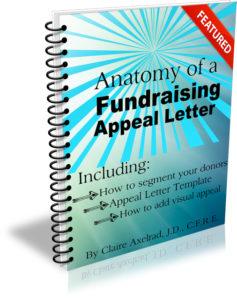 Does proving your point persuade your nonprofit donor?
Does proving your point persuade your nonprofit donor?
It turns out not so much.
At least, not unless your donor is already pretty much won over.
Proof, absent persuasion, won’t get you far.
In my last article, “How to Project Manage Your Nonprofit Story,” I delved into the concept of story vs. data in creating compelling nonprofit marketing and fundraising copy. Stories almost always win out, because human beings are wired for stories. To want to enter into them. To want to become a part of them. To want to see ourselves, in some way, expressively reflected in the characters, plot and struggle.
In this way we are emotionally moved. We shed a tear… get a lump in our throats… find ourselves chuckling, smiling or even beaming with a flicker, or a flame, of recognition, appreciation or gratitude. We are taken out of our everyday lives, and moved someplace else where we’re offered a new perspective. From this perspective, we can choose to act. To become part of the story, in a positive way. To make a difference. To bring joy to sadness… hope to despair… healing to hurt. To bring the happy ending we wish to see.
Today I want to delve a bit deeper into why stories beat data because, when I review nonprofit appeals, the lion’s share do a poor job of making the story the star. Sure, you may be raising money with your appeal. But I’ll bet dollars to donuts you could raise a lot more by channeling the persuasive power of a compelling narrative.
Stories are persuasive, having the power to change audience beliefs and actions.
If you’re familiar with Robert Cialdini, you’ll know about the six key principles of influence and persuasion that help people to act in the face of uncertainty. And we’re all in that state of uncertainty when we receive a fundraising appeal, right? If you look closely, you’ll see these principles are story-based:
- Reciprocity – the story of giving back and paying forward, making the giver a good person
- Commitment – the story of acting consistently, in accordance with one’s values
- Social proof – the story of joining with others doing similar things
- Scarcity – the story of not missing out on an opportunity
- Authority – the story of following in the footsteps of others one respects
- Liking – the story of liking something, or someone, because of shared commonality
It’s always a good idea to use one or more of these persuasion levers in a fundraising appeal and, if you tell stories, you’ll almost naturally do so!
Here’s an example of one of the greatest fundraising letters of all time for Covenant House. I doubt the writer was consciously thinking about Cialdini’s principles while crafting this story, but they’re there if you read between the lines. It’s partly because the tone is so direct and personal the reader naturally likes the writer. They may also respect them as an authority on the subject. Plus, the letter assumes any good person would want to help in the described situation, and in fact they are! [“Almost all of the money that we need to help these kids comes from people like you.”] This acts as social proof and triggers the reader’s sense of commitment. Empathy is engendered [“A good kid should not be allowed to fall victim to the terror of street life.”], and may trigger feelings of reciprocity if the reader, or someone they know, was similarly helped.
NOTE: The organization which raised millions of dollars with this letter, over many years, ultimately ran into a major scandal. The writer of the original letter was fired, and the SOFII writer, Denny Hatch, describes how Covenant House rose from the ashes, also using the power of story. Finally, he shares a new fundraising letter – an equally powerful example of persuasive storytelling — written by the new CEO.
Data and analysis may prove a persuasive point, but won’t do an effective job effecting action.
Imagine telling your audience one in five people in your community, and one in four seniors, are hungry. Add in the fact a quarter of all families with children experience food insecurity. They’re certainly surprising datapoints. Even, potentially, shocking. But, to the donor, they’re still just numbers. The donor can’t relate to this “evidence” of poverty. They can’t put a face to it. They can’t imagine the far-reaching impacts of this state of affairs on a child’s, mother’s, or grandmother’s life. It’s just hard, cold data, raising more questions than it answers.
When presented with data the donor is forced to think, not feel. What do these numbers mean? Is it one in four or five throughout the city, or only certain neighborhoods? What is the definition of “hungry?” Is it all food that’s lacking, or just nutritious or fresh food? Is it chronic, or based on other factors like unemployment? And, so on. With data, our minds jump to the task of question-asking and analysis.
We’re not persuaded of the problem, and the need to resolve it, as much as stimulated to better define the problem.
Stories + data is still problematic, taking people down the pathway of thought, not emotions.
You’d be forgiven if you’re thinking, surely, persuasion plus proof is the best solution. It seems logical. But therein lies the problem. You see, our emotional selves simply are not moved by logic. At least not most of the time.
There’s a famous 2007 experiment about “the identifiable victim effect,” using a Save the Children appeal. In that study, those who received a fact-based appeal from Save the Children donated $1.14. Those who read a story about an individual child in need donated an average of $2.38, more than twice as much.
Combining a story with data didn’t significantly improve results. In fact, it only yielded an average gift of $1.43. Why? The researchers called this the “drop in the bucket effect.” People were moved by the individual child’s story. Then, when they read the numbers, they just felt overwhelmed by the scope of the problem. So, they gave less.
There are two instances where data can be used.
But sparingly. If you overdo it, you’ll get people thinking rather than acting. Combining data with narrative can help a little, but the numbers still lead people to discount the problem’s scope unless you’re careful.
1. Data to help donors envision others who, like the protagonist, need their help.
In the two story-based fundraising appeals from Covenant House, data was used – at the very end – to demonstrate the problem was a large-scale one. But, because the story had already been told in great detail, the problem didn’t seem amorphous. Readers can easily visualize all the other kids in need, and what their stories might be.
[First Letter: “But sadly, not all of the more than 20,000 kids who come to Covenant House this year will be that lucky. These kids have very few options.”] In other words, they’ll only be lucky if, like the story protagonist, they have the reader’s help. The reader can give these stories happy endings.
[Second Letter: “This year more than 41,000 homeless kids… kids who are 12, 16, 17 years old… will come to our doors… Thanks to the love and support of thousands of caring people – people just like you – Covenant House spends MORE than the entire federal government to help these kids.”] In other words, if people like you don’t help, the doors won’t stay open. And certainly, the government won’t help provide happy endings!
2. Data to get you over the hump with some major donors.
There are exceptions to every rule. And while most people are ruled by their hearts when it comes to giving, the contemplation of five, six or seven figure gifts can bring other thought processes into play. Is this really the right amount to make an impact? Will there be enough other donors at this level to reach the goal? What processes are in place to assure the money is well spent? Can I afford it?
Don’t get me wrong. First, you must persuade. And here, stories are your best friend. Once the donor is persuaded, however, you may need to reinforce their decision-making with a little proof. This is why capital campaigns offer donors gift charts, graphs, and budgets. Knowing you’ve done your homework reassures them they’ve done theirs.
But don’t overdo it.
“When you do a superb job of proving yourself to be right, it doesn’t necessarily change your audience’s beliefs or make them take action. Yet, throughout history, one doesn’t need to look very far to notice that people don’t need a whole lot of proof to believe and do… all sorts of things.”
— Esther Choy, Author, “Let the Story Do the Work” and CEO of Leadership Story Lab
Have the data at hand to use if you’re asked. And always, always be prepared to persuade. Walking into a major donor visit armed with charts and graphs, and no compelling, emotional stories up your sleeve, is a recipe for disaster. Or, if not disaster, at least significant delay while they ponder the data and “think about it.”
Summary: Stories vs. Data in Fundraising
Individual fundraising appeals are not news stories or grant proposals. They don’t benefit from a long recitation of facts and figures. Numbers in trouble. Numbers helped. Statistics, data and analysis. No.
Individual fundraising appeals benefit from key principles of persuasion. These triggers naturally help people faced by uncertainty by serving as decision-making shortcuts. Yes.
Individual fundraising appeals benefit from stories told with emotion, using colorful, descriptive narrative to help the reader visualize the characters and action. Yes.
Individual fundraising success relies on feeling, not reason. The difference between emotional persuasion and logical proof is emotion. The latter makes you think, the former makes you act. When the two are in conflict, emotion always wins. Truth.
People forget facts, but they never forget a good story. TRUTH.
Want More Help With Fundraising Appeal Tactics?
 Get my Anatomy of a Fundraising Appeal + Sample Template — a thorough e-Guide with everything you need to put together an offer your prospect can’t possibly refuse!
Get my Anatomy of a Fundraising Appeal + Sample Template — a thorough e-Guide with everything you need to put together an offer your prospect can’t possibly refuse!
This is super practical stuff I’ve learned over the past 35+ years. Plus, I’ll explain to you why I’m suggesting you take the recommended actions — so if anyone tries to dissuade you from doing what you know works, you’ll have the ammunition you need to stick to your guns. That’s how you’ll raise more money.
I guarantee you’ll raise way more than the modest cost of this Guide. If you’re not satisfied, you have my no-questions-asked, 30-day, 100% refund guarantee.
This 62-page e-Guide is a surprisingly quick read — and a true road map to creating a winning fundraising appeal.
Storytelling photo by Emmanuel Offei on Unsplash




